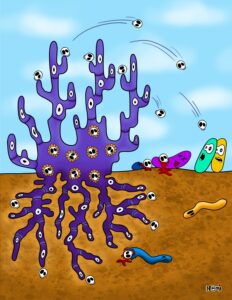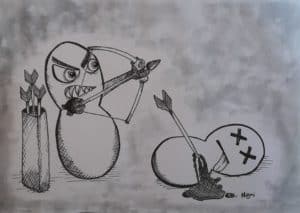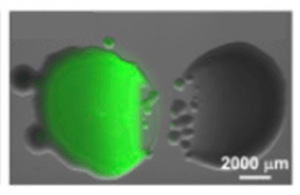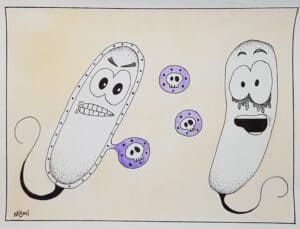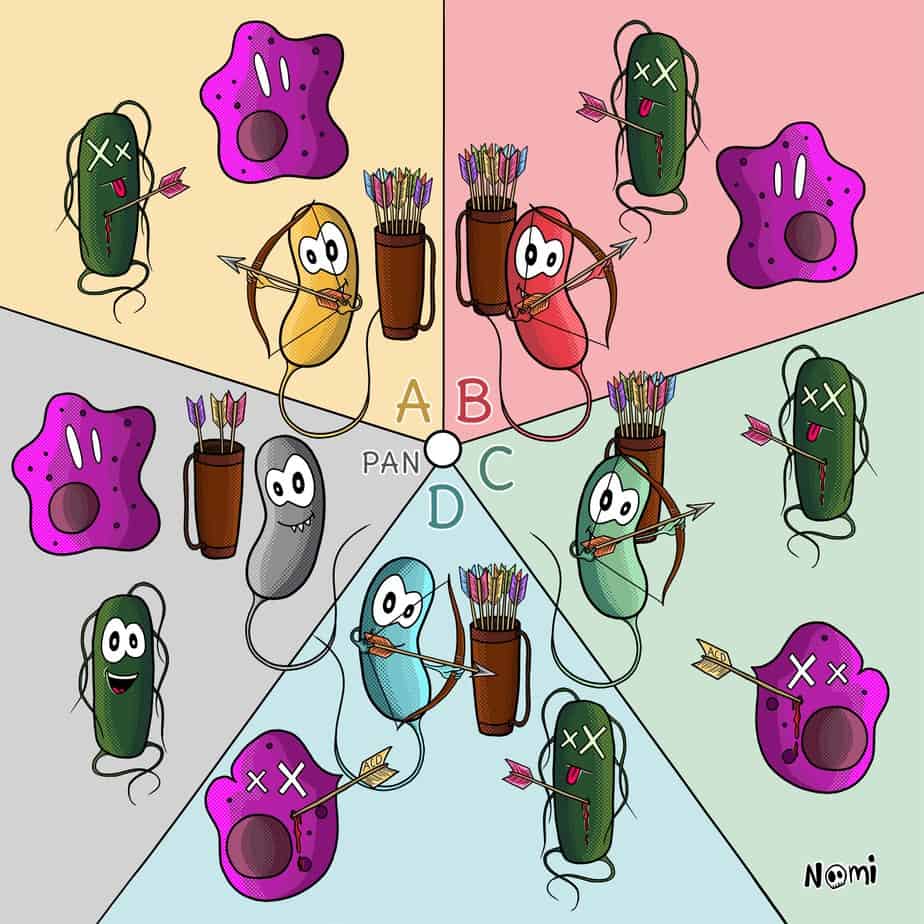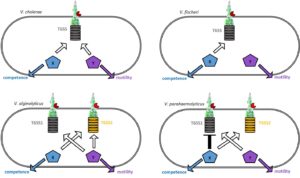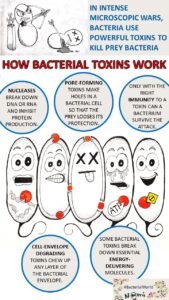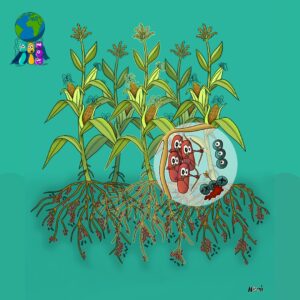Bacteria can be extremely nasty and fight each other regularly.
They have killer weapons to deliver lethal toxins into other microbes.
And by killing their surrounding competitors, they make space for themselves.
Like this, they conquer new places and environments wherever they go.
But some bacteria are even more sneaky than that. They don’t kill bacteria directly. Rather, they destroy the houses that bacteria live in.
This leaves the prey exposed to the harsh environment. And the attacker can claim the now available space.
Where do these kinds of battles happen? According to researchers, they might even happen in or on our bodies.
Let’s have a look at how bacteria fight by destroying each other’s houses.
Bacteria build biofilm houses
Just like us, when bacteria feel comfortable in a place, they start building houses to settle down. They grow within these houses, multiply, invite their neighbours and become social.
A happy life.

One bacterium that is a master in biofilm house building is the Escherichia coli UPEC. This pathogenic bacterium can grow in the urinary tracts of people and cause nasty bladder infections.
In bladders or on catheters, UPEC can also build biofilms. Here, it wraps itself into a thick layer of slime to protect itself from the surrounding. In this biofilm house, no molecules, like antibiotics, or other bacteria can harm UPEC.
It seems to be protected from almost any attack.
Almost.
Bacteria fight microscopic battles
Now, researchers found that even UPEC has bacterial competitors. These live in similar places like UPEC, so they already know each other.
That’s why UPEC’s opponents came up with a special strategy to make UPEC miserable. They learned to destroy UPEC’s biofilm houses. This is meant to weaken UPEC so that other antibacterial factors now have an effect.
What does that mean?
The UPEC bacterium is pretty nasty for us since we need high doses of antibiotics to get rid of it. And we know that taking antibiotics is not a good thing. So, researchers are looking for new weapons to fight this bacterium.
The idea is that if we understand how other bacteria fight UPEC, we could learn from them. Maybe we could work out similar ways to fight UPEC.
Bacteria fight by destroying biofilms
Researchers found that some bacteria produce compounds that stop UPEC from producing biofilm. One of these attackers is Salmonella enterica Typhimurium. This bacterium even developed a strategy to exclude UPEC from its own biofilm house.
Researchers showed that Salmonella produces a toxic sugar that inhibits UPEC from forming a biofilm. Like this, Salmonella directly stops UPEC from colonising new spaces.
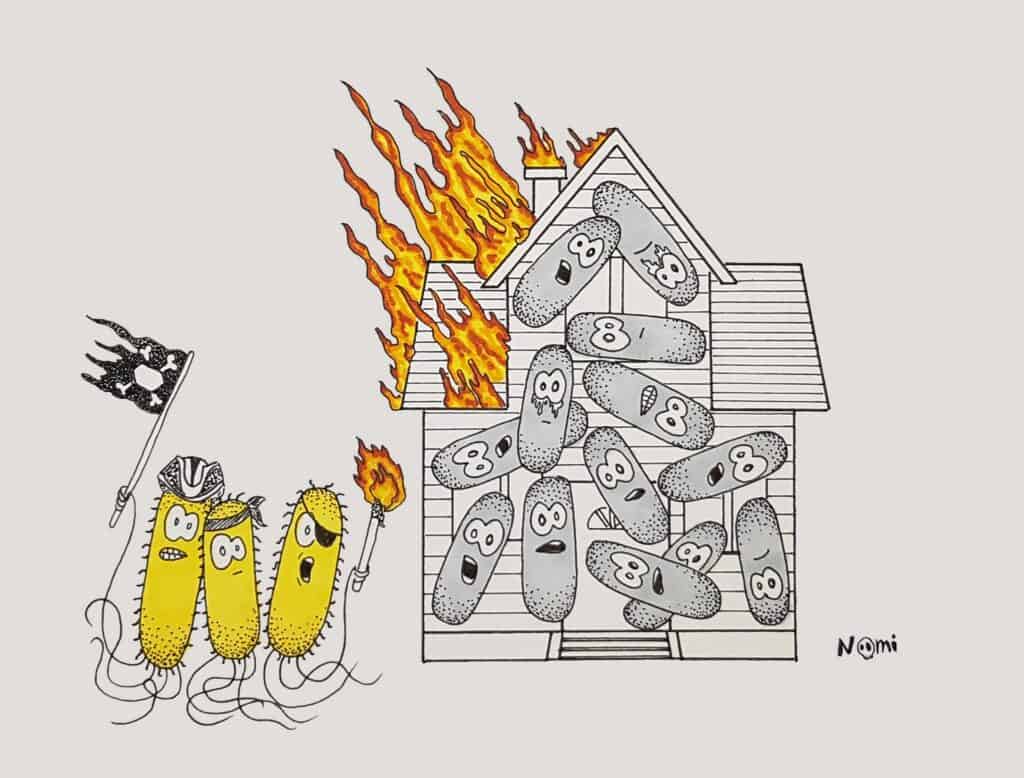
Another bacterium, Lactobacillus acidophilus, produces a similar sugar. Researchers showed that this toxin also stops UPEC from building a biofilm.
However, it is still not clear how these sugars exactly work to inhibit biofilm production.
Bacteria fight by producing biofilm
The researchers also found that Salmonella and UPEC did not grow well together. Separated from each other, they were happy. Together, they were just fighting.
But something else was interesting: In a mixed biofilm, Salmonella managed to outgrow UPEC. It was growing faster and produced a lot more biofilm than UPEC.
This could mean that Salmonella tries to suffocate UPEC with biofilm. The researchers thought that the Salmonella bacteria grow on top of the biofilm, where they have more oxygen. Like this, the UPEC bacteria would be buried by all this biofilm slime and get less oxygen and eventually die.
Surely not a nice way to go!
What can we learn from these bacterial battles?
This study told us a lot about how bacteria live together and fight each other. Researchers are constantly looking for new ways to kill those bacteria that we cannot fight with antibiotics anymore. Based on this, we can even use bacteria as biocontrol agents to fight other pathogenic bacteria.
For example, Salmonella produces a compound that stops UPEC from forming biofilms. If we better understand how this toxin works, we might have a new method to inhibit bacteria from colonising surfaces in hospitals.
Also, UPEC and Salmonella are pathogenic bacteria and they can survive in wastewater even after cleaning. This is a major health issue. Hence, finding new ways to fight these bacteria will help us live healthier and safer.
This study was a small step in the grand fight against superbug bacteria. But those small steps are often the most important ones.


